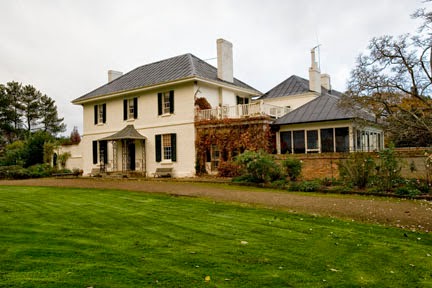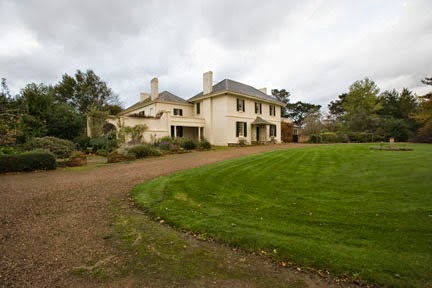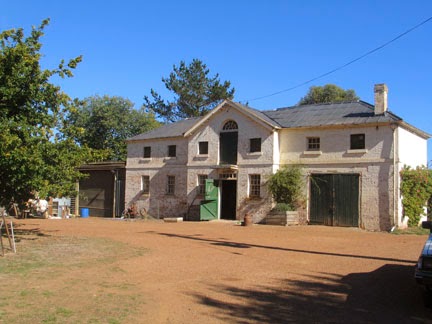Originally known as 'Wattle Park', the Brickendon estate was originally granted to William Whyte, but was taken over by Thomas Archer (1790-1850) of Woolmers and subsequently by William Archer (1788-1879) who in 1824 had migrated to Van Diemen's Land to join his brother Thomas. Located across the Macquarie River from Woolmers, William Archer renamed the farm Brickendon after a village near his birthplace in Hertfordshire, England.
William Archer established a mixed farming property on the 420 ha (985 acre) grant. Amongst the merchandise accompanying Archer on the ship “Aguilar” were 77 pure merino ewes and 3 rams, a Norman cow and bull, many pigs and two horses. The Archers were amongst the first settlers in Van Diemen’s Land to 'improve' their livestock in order to take advantage of the new opportunities in the fine wool export trade.
Following his marriage in 1829 to Caroline Harrison, William Archer had a grand Georgian house built, set in an elaborate garden with accompanying domestic servants’ wing, stables complex and brick houses for a coachman and gardener. The garden was laid out by William Archer in 1831 and specimen trees planted during the 1830s were sourced from around the world. Changes to the design of the garden reflect later plantings by subsequent generations of the Archer family. The homestead complex with its formal architectural style and garden layout was located at some distance from the farm buildings to separate the residence from the working area, demonstrating the family’s status and authority.
The homestead was designed with a central block and two double storey wings. They enclose a courtyard that is protected by a wall and gates that form the forth side of the square. Here staff and livestock could take refuge if the estate was attacked by bushrangers or aborigines. A large bell above the gates was used to call workers to meals and as an alarm, it is dated 1836. The main house was the first section completed in 1828 with more than 300,000 bricks made on the farm. Here William Archer brought his new bride and Archers have lived here ever since.
The Northern wing was constructed in the 1830’s and was the working and servants wing with female convicts quarters, an upstairs nursery and numerous rooms with sandstone floors downstairs used for food storage and preparations. The Southern wing, also built in the 1830’s, provided accommodation for visitors and an impressive library upstairs and gentlemen’s sitting rooms and offices downstairs. This wing is notable for its roofing slate imported from Wales and large panes of glass, only affordable to families of means.
As a male servant of the highest status, the Coachman had the most comfortable cottage on the estate with two bedrooms upstairs and kitchen, living room, store and office downstairs. The coachman cared for the horses and carriages in the nearby Coach House and Stable. The brick and wooden Coach House and stables could accommodate 4 carriages and up to 10 horses. The Coachman was expected to be available at a moments notice. Of lower status than the coachman, the gardener has a single story cottage which boasted 4 rooms. The gardener was responsible for the orchard, vegetable and ornamental garden.
The estate gardens form a very special living record of garden design over the past two centuries. The first William Archer laid out the original gardens in the 1830’s . He designed them in the latest English fashion of the time which created more natural looking landscapes than the manicured lawns and rigid patterns of beds for the previous period. He also began to develop the hawthorn hedges, which are rare in Australia. They now stretch for 30kms across the whole estate.
There are also elements of the English rural estates in the carriage driveways, orchards, lawns and gardens as well as the location of the main residence to take advantage of distant views.
A sale brochure for Brickendon in 1895 depicts the 1120 acre estate, of which about 750 acres were cleared and cultivated. The property however was not sold and remains in the possession of William Archer’s descendants.
Today the Archer family carries on the mixed farming tradition of their forbears with cattle and sheep grazing and intensive cropping although today the Archers are able to take advantage of the latest in machinery and research.
Part of the property was used in the filming of 'My Brilliant Career' to convey the lifestyle of the early landed gentry of eastern Australia.
Brickenden Estate is one of 11 historic sites that together form the Australian Convict Sites World Heritage property which were officially listed on the UNESCO World Heritage List in July 2010 because of its outstanding significance within the Australian convict system.
Main Text & Information
Source: Brickendon Information Brochure
Stay Tuned!























